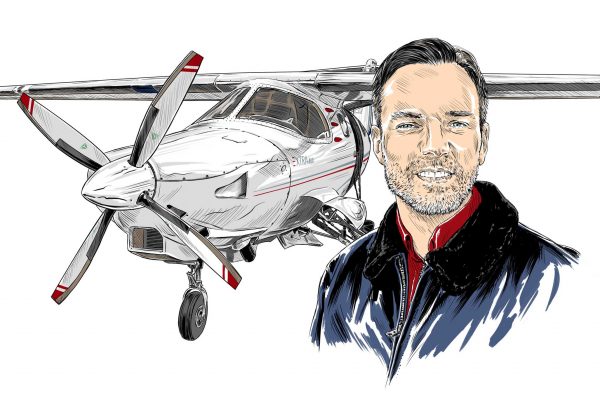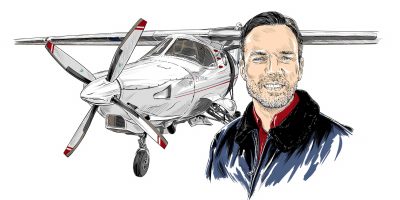Pursuing the Q&A as part of the CAA Virtual Voyage presentation series, I noticed the all too familiar subject of RNP instrument approach procedures (or lack thereof) at GA aerodromes featured. The particular question was regarding why some recently published IAPs have restrictions on use, but also alluded to their generally slow appearance in the UK.
The term ‘RNP’ stands for ‘Required Navigation Performance’ – indicating that to fly the approach, the navigation equipment onboard needs to meet specified accuracy and integrity requirements. ‘RNP’ is a relatively recent change of nomenclature for describing an approach procedure – previously terms such as ‘GPS’, ‘GNSS’ and/or RNAV(GNSS) were more common. Associated with RNP approaches are the different categories of landing ‘minima’, such as LNAV (without vertical guidance) or LPV (Localiser Performance with Vertical guidance). One side effect of the UK leaving the EU is that LPV approaches are no longer available since they rely on the European EGNOS signal augmentation system.
The first GNSS approaches appeared in the UK in 2006. There was a CAA trial in the summer of 2006, for which GNSS approaches were published at several aerodromes (including GA ones such as Shoreham and Gloucestershire) and pilots holding an instrument qualification were encouraged to give feedback on their use. Fifteen years later though, uptake by GA aerodromes outside of the original trial members has been limited. This is unfortunate, since I think with more approaches, the utility and viability of GA would be improved.
Business sense
A historical barrier was the UK requirement for an approach control service to be provided for instrument approach procedures. Few GA aerodromes in the UK have ATC, and upgrading for the purposes of obtaining an IAP was unlikely to make business sense. A policy for exempting from the requirement was published by the CAA in 2014, but to date only a few aerodromes have gained approval.
People are often quick to point out that the situation abroad is better. Go to the USA, for example, and approaches are published to many GA aerodromes. There are infrastructure differences that make the comparison less straightforward though – in many countries regional ATC centres provide approach control services and the state takes a more active role in designing and publishing procedures.
In the UK, a much higher burden falls on aerodromes to devise and fund procedures, including going through the ‘Airspace Change Process’ (even when not applying for airspace as part of the application), so the business case is often weak. The CAA long ago stopped designing procedures itself, and this is now done on a commercial basis. In some circumstances 50% funding is available from the Department for Transport, but the organisational burden associated with navigating the approval process is still quite high, although this will hopefully come down as more aerodromes go through it.
Despite the cost and organisational challenges for aerodromes, there will likely be more RNP approaches without ATC in the UK over the next few years and these will have some additional considerations for pilots compared to those in the ATC environment.
Of the few currently in the AIP (Sywell and Kemble for example), use of the procedures is by prior permission and notes on the procedure charts make it clear there is no ATC service or separation with other traffic provided. The aircraft avionics and pilot qualifications needed to fly them are no different from any other RNP approach though.
When this subject first arose in the UK, there was much discussion about the risks of conflict between inbound IFR traffic and VFR traffic that may be operating at the aerodrome. Experience in other states suggests this is largely a non-issue.
When VFR weather prevails, most GA IFR traffic should have no problem integrating visually. Many states where this takes place typically have rules or guidance on IFR operations at uncontrolled aerodromes published in the AIP. I suggest in due course the CAA adopts some common procedures based on practice elsewhere.
Multiple aircraft usage
Another issue to contend with is sequencing of IFR arrivals – in many places this is achieved remotely, but in the UK most lower airspace ATC only serves airports and associated airspace, unless participating in the Lower Airspace Radar Service (LARS). It looks like most UK IAPs without approach control will be PPR, to stop multiple aircraft trying to use them at the same time.
Personally, it seems unlikely to me that demand would be such that this would be an issue in practice and perhaps on the occasion it did happen, self-separation over the radio would work. Another solution would be regional approach control, as in France or Germany, but again someone would likely have to pay for this.
Approaches in Class G do raise issues of conflict with other traffic in the uncontrolled environment, although historical evidence suggests that there is limited risk when in IMC. I suspect most of the risk can be mitigated by keeping a good lookout while in VMC and using electronic conspicuity as appropriate. In the commercial world, reducing speed where possible and always using the autopilot, so as to devote more attention to lookout, is standard practice for IFR operations outside of controlled airspace.
I do not predict many of them, but 2022 should see some additional approaches appear in the AIP and hopefully GA pilots can start to make use of them.




